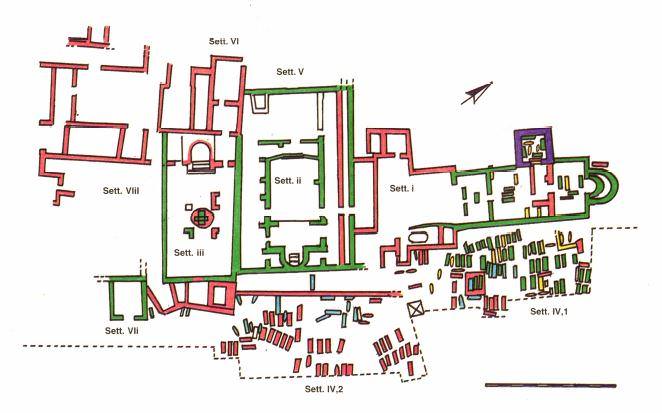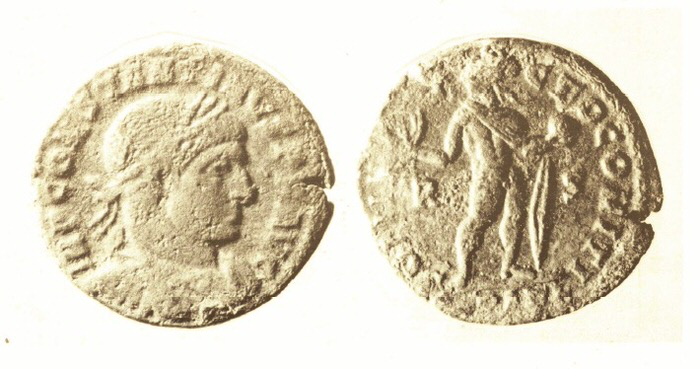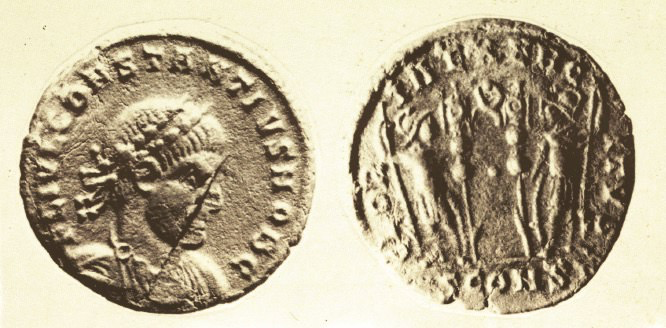Coins
About three hundred coins all in bronze covering a period going from the Punic era (IV-III A.D.) and the early Middle Ages (VI century A.D.) were found in the cemetery area of Columbaris (fig.1).
The Punic Era coins were coined by Sardinian and Sicilian mints between 380-330 and 264-238 B.C., while only two lines are known for the Republican Period (217-197 B.C.), (fig. 2).


They found examples from the imperial Roman period (figs. 3-5) datable from the III till the VI century A.D. and twenty eight vandal coins (fig. 6).




Those finds prove use of the coin with ritual value, as they were not only found in the tomb, as viaticum payment or for Charon (e.g. tombs 15, 77), but also outside them, as an offering (e.g. tombs 35, 36, 44), and both inside and outside (e.g. tombs 20, 21, 26) and near tables prepared for the refrigerium (t. 26). Tombs 75 and 76 held coin hoards.
Finding Punic and Roman examples, no longer used or with coins referable to different periods indicates that, once they had lost their monetary value, they acquired a ritual one and certified the survival of pagan rituals. In the classic religion, both Greek and Roman, Charon ferried the souls of the dead from one shore to the other of the Acheron, the river of Hades (fig. 7): with a fee the ferryman would have taken the deceased person's soul to the other side, so his loved ones, to guarantee the journey, would have left a coin in the grave.

In Sardinia that practice is proven by several tombs from the Roman Period to the late Antiquity one (for example Sant’Imbenia, Sassari, and Loc. Cuccuru Porceddus, Decimoputzu) and the full Middle Ages one (in Posada) and post-medieval (Sant’Eulalia a Cagliari, where coins found are from the Savoy Period).
Moreover numerous coins, both bronze and gold, were found all over the Cornus area and on the hill of Corchinas, also referable to the vast time period partly found in Columbaris, that is from the Punic era to the end of the VII century (see fig. 8).

Bibliografia
- C. AMANTE SIMONI, Il contributo numismatico, in AA.VV., L'archeologia romana e altomedievale nell'Oristanese. Atti del Convegno di Cuglieri (22-23 giugno 1984) = Mediterraneo tardoantico e medievale, Scavi e ricerche, 3, Taranto 1986, pp. 103-133.
- C. AMANTE SIMONI, Le monete, in C. AMANTE SIMONI, A. M. GIUNTELLA, L. PANI ERMINI, D. STIAFFINI, Ricerche di archeologia post-classica nella Sardegna centro-medievale, in Quaderni della Soprintendenza Archeologica per le Province di Cagliari e Oristano, 4, II, 1987, pp. 81-83.
- C. AMANTE SIMONI, Sepoltura e moneta: obolo viatico - obolo offerta, in AA. VV., Le sepolture in Sardegna dal IV al VII secolo. IV Convegno sull'archeologia tardoromana e medievale (Cuglieri 27-28 giugno 1987) = Mediterraneo tardoantico e medievale. Scavi e ricerche, 8, Oristano 1990, pp. 231-242.
- C. AMANTE SIMONI, A. M. GIUNTELLA, L. PANI ERMINI, D. STIAFFINI, Ricerche di archeologia post-classica nella Sardegna centro-medievale, in Quaderni della Soprintendenza Archeologica per le Province di Cagliari e Oristano, 4, II, 1987, pp. 79-103.
- V. ANGIUS, s.v. Corchinas, in G. CASALIS, Dizionario storico-statistico, geografico-commerciale degli stati di S. M. il Re di Sardegna, V, Torino 1839, pp. 404-408.
- P. BASOLI, R. CAPRARA, R. D’ORIANO, F. GUIDO, D. LISSIA, F. LO SCHIAVO, M. MADAU, F. MANCONI, M. R. MANUNZA, P. PALA, D. ROVINA, A. SANCIU, M. C. SATTA, L’archeologia tardo-romana e medievale nella Sardegna centro-settentrionale: 1984-1986, in AA. VV., Il suburbio delle città in Sardegna: persistenze e trasformazioni. Atti del III Convegno di studio sull’archeologia tardoromana e altomedievale in Sardegna (Cuglieri, 28-29 giugno 1986) = Mediterraneo tardoantico e medievale. Scavi e ricerche, 7, Taranto 1989, pp. 11-61.
- F. BISCONTI, La decorazione delle catacombe di Roma, in V. FIOCCHI NICOLAI, F. BISCONTI, D. MAZZOLENI, Le catacombe cristiane di Roma. Origini, sviluppo, apparati decorativi, documentazione epigrafica, Regensburg 2002, pp. 70-145.
- A. BOSCOLO, Sepolture in Sardegna nell’Alto Medioevo, in Archivio Storico Sardo, XXXVI, 1989, pp. 77-82.
- Cornus I.1 = A. M. GIUNTELLA, Cornus I.1. L'area cimiteriale orientale = Mediterraneo tardoantico e medievale. Scavi e ricerche, 13. 1, Oristano 1999, pp. 83-87, 200.
- CUGLIERI I = AA.VV., L'archeologia romana e altomedievale nell'Oristanese. Atti del Convegno di Cuglieri (22-23 giugno 1984) = Mediterraneo tardoantico e medievale, Scavi e ricerche, 3, Taranto 1986.
- C. D’ANGELA, L’obolo a Caronte. Usi funerari medievali tra paganesimo e cristianesimo, in Quaderni medievali, 15, 1983, pp. 175-182.
- C. D’ANGELA, Contesti tombali tardoantichi e altomedievali, in Caronte. Un obolo per l’aldilà, in La parola del passato. Rivista di studi classici, III-IV, 1995, pp. 319-326.
- A. M. GIUNTELLA, Note su alcuni aspetti della ritualità funeraria nell’alto medioevo. Consuetudini e innovazioni, in G. P. BROGIOLO, G. WATAGHIN (a cura di), Sepolture tra IV e VIII secolo. 7° Seminario sul tardo antico e l’alto medioevo in Italia centro settentrionale (Gardone Riviera, 24-26 ottobre 1996) = Documenti di archeologia, 6, Mantova 1998, pp. 66-67.
- A. M. GIUNTELLA, G. BORGHETTI, D. STIAFFFINI, Mensae e riti funerari in Sardegna: la testimonianza di Cornus = Meditarraneo Tardoantico e medievale. Scavi e ricerche, 1, Taranto 1985.
- F. GUIDO, Note sulla monetazione sardo-bizantina, in P. CORRIAS, S. COSENTINO (a cura di), Ai confini dell’impero: storia, arte e archeologia della Sardegna bizantina, Cagliari 2002, pp. 165-170.
- D. LISSIA, Alghero. Loc. S. Imbenia. Insediamento e necropoli di età tardo-romana e altomedievale, in P. BASOLI, R. CAPRARA, R. D’ORIANO, F. GUIDO, D. LISSIA, F. LO SCHIAVO, M. MADAU, F. MANCONI, M. R. MANUNZA, P. PALA, D. ROVINA, A. SANCIU, M. C. SATTA, L’archeologia tardo-romana e medievale nella Sardegna centro-settentrionale: 1984-1986, in AA. VV., Il suburbio delle città in Sardegna: persistenze e trasformazioni. Atti del III Convegno di studio sull’archeologia tardoromana e altomedievale in Sardegna (Cuglieri, 28-29 giugno 1986) = Mediterraneo tardoantico e medievale. Scavi e ricerche, 7, Taranto 1989, pp. 29-38.
- G. LULLIRI, La monetazione, in G. LULLIRI, M.B. URBAN, Le monete della Sardegna vandalica. Storia e numismatica, Sassari 1996, pp. 59-172.
- R. MARTORELLI, Le monete, in A. M. GIUNTELLA (a cura di), Cornus I. 2. L'area cimiteriale orientale. I materiali = Mediterraneo tardoantico e medievale, 13. 2, Oristano 2000, pp. 50-105.
- P. PEDUTO, Osservazioni sul rito in epoca medievale, in Caronte. Un obolo per l’aldilà, in La parola del passato. Rivista di studi classici, III-IV, 1995, pp. 311-317.
- F. PINNA, Il corredo funerario nella Sardegna post-medievale: la cripta della chiesa di S. Eulalia a Cagliari, in S. LUSUARDI SIENA, Fonti archeologiche e iconografiche per la storia e la cultura degli insediamenti nell’altomedioevo. Atti delle giornate di studio (Milano-Vercelli, 21-22 marzo 2002) = Contributi di Archeologia, 3, Milano 2003, pp. 323-335.
- A. SANCIU, Posada, Parte Sole, le sepolture e le tombe, in P. BASOLI, R. CAPRARA, R. D’ORIANO, F. GUIDO, D. LISSIA, F. LO SCHIAVO, M. MADAU, F. MANCONI, M. R. MANUNZA, P. PALA, D. ROVINA, A. SANCIU, M. C. SATTA, L’archeologia tardo-romana e medievale nella Sardegna centro-settentrionale: 1984-1986, in AA. VV., Il suburbio delle città in Sardegna: persistenze e trasformazioni. Atti del III Convegno di studio sull’archeologia tardoromana e altomedievale in Sardegna (Cuglieri, 28-29 giugno 1986) = Mediterraneo tardoantico e medievale. Scavi e ricerche, 7, Taranto 1989, pp. 55-57.
- G. SPANO, Ultime scoperte, in Bullettino archeologico sardo, 4, 12, Nuoro 1858, pp. 187-189.
- C. TRONCHETTI, Il territorio dell’Oristanese in età romana, in AA.VV., L'archeologia romana e altomedievale nell'Oristanese. Atti del Convegno di Cuglieri (22-23 giugno 1984) = Mediterraneo tardoantico e medievale, Scavi e ricerche, 3, Taranto 1986, pp. 17-22.

 VR
VR